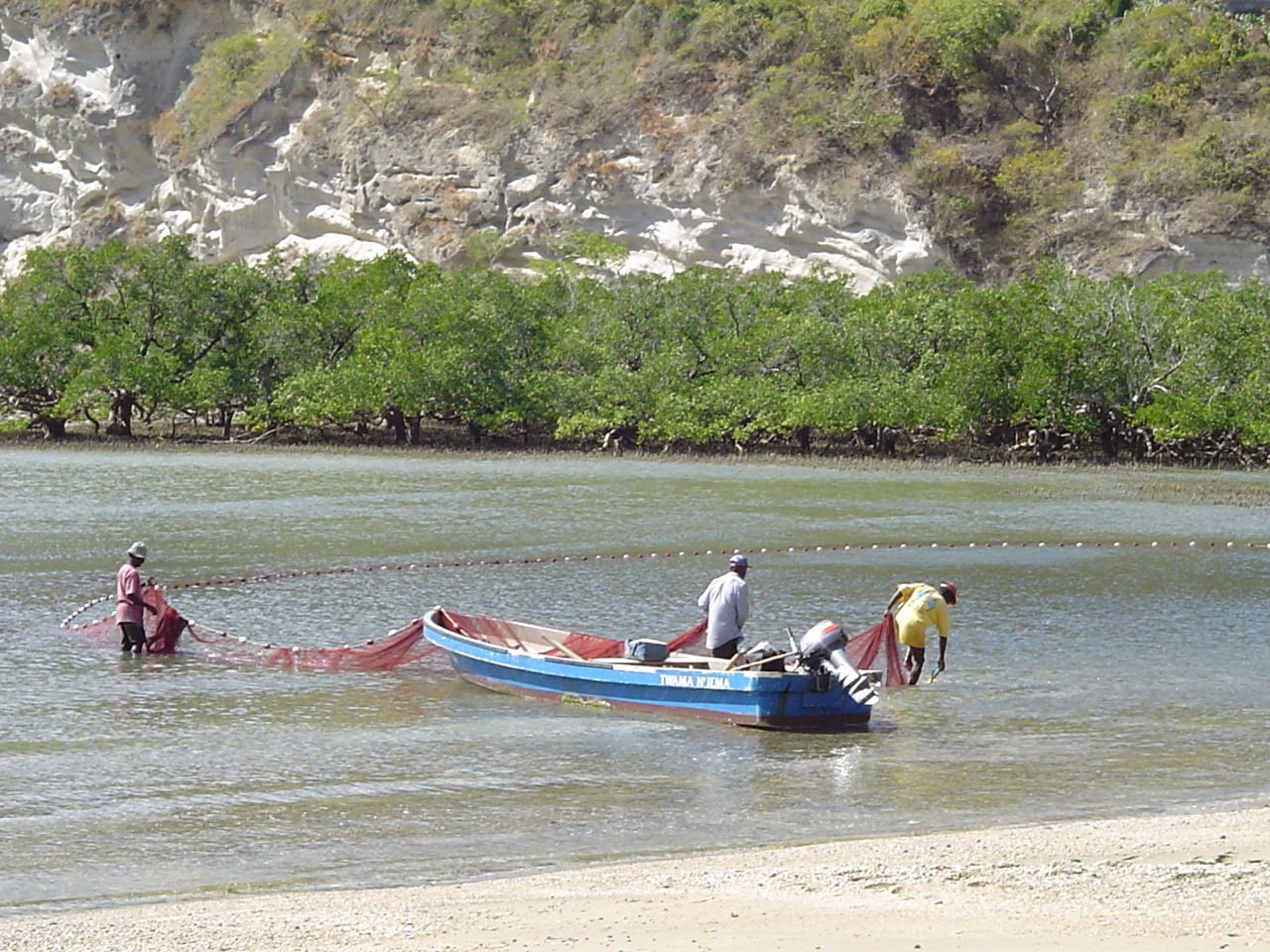Panga (skiff) on:
[Wikipedia]
[Google]
[Amazon]
The panga is a type of modest-sized, open, outboard-powered, fishing boat common throughout much of the developing world, including Central America, the Caribbean, parts of Africa, the Middle East, and much of Asia. The original panga design was developed by 
 Key features of the panga design are a high bow, narrow waterline beam, a delta shaped running surface, and a flotation bulge along the gunwale, or top edge of the hull. The high bow provides buoyancy for retrieving heavy nets, and minimizes spray coming over the bow. The narrow beam allows the hull to be propelled by a modest outboard motor. The flotation bulge along the gunwale provides increased stability at high angles of roll. These features link the panga design to traditional Japanese wasen fishing boats.
The original Yamaha panga design had a length of , and a waterline beam of approximately . The flotation bulge at the gunwale increased the overall beam to approximately .
Pangas are usually between in length, with capacities ranging from and powered by outboard motors of between . Their planing hulls are capable of speeds in excess of .
The hulls are made of
Key features of the panga design are a high bow, narrow waterline beam, a delta shaped running surface, and a flotation bulge along the gunwale, or top edge of the hull. The high bow provides buoyancy for retrieving heavy nets, and minimizes spray coming over the bow. The narrow beam allows the hull to be propelled by a modest outboard motor. The flotation bulge along the gunwale provides increased stability at high angles of roll. These features link the panga design to traditional Japanese wasen fishing boats.
The original Yamaha panga design had a length of , and a waterline beam of approximately . The flotation bulge at the gunwale increased the overall beam to approximately .
Pangas are usually between in length, with capacities ranging from and powered by outboard motors of between . Their planing hulls are capable of speeds in excess of .
The hulls are made of
Yamaha Yamaha may refer to:
* Yamaha Corporation, a Japanese company with a wide range of products and services, established in 1887. The company is the largest shareholder of Yamaha Motor Company (below).
** Yamaha Music Foundation, an organization estab ...
as part of a World Bank project circa 1970.Panga history at Allmand Boats. Retrieved from http://allmandboats.blogspot.com/.Panga history at Microskiff. Retrieved from http://www.microskiff.com/reviews/boats/PangaMarine_18_skiff.html.Panga article at Soundings Online. Retrieved from http://www.soundingsonline.com/features/type-of-boat/178-the-versatile-panga-is-coming-of-age-. Pangas are commonly operated directly off beaches.Video of a panga landing on a beach in Mexico. Retrieved from https://www.youtube.com/watch?v=uNW0n9PlKGc The name comes from the panga fish, which is commonly netted. The upswept bow of the boat resembles the machete or knife called a panga.

 Key features of the panga design are a high bow, narrow waterline beam, a delta shaped running surface, and a flotation bulge along the gunwale, or top edge of the hull. The high bow provides buoyancy for retrieving heavy nets, and minimizes spray coming over the bow. The narrow beam allows the hull to be propelled by a modest outboard motor. The flotation bulge along the gunwale provides increased stability at high angles of roll. These features link the panga design to traditional Japanese wasen fishing boats.
The original Yamaha panga design had a length of , and a waterline beam of approximately . The flotation bulge at the gunwale increased the overall beam to approximately .
Pangas are usually between in length, with capacities ranging from and powered by outboard motors of between . Their planing hulls are capable of speeds in excess of .
The hulls are made of
Key features of the panga design are a high bow, narrow waterline beam, a delta shaped running surface, and a flotation bulge along the gunwale, or top edge of the hull. The high bow provides buoyancy for retrieving heavy nets, and minimizes spray coming over the bow. The narrow beam allows the hull to be propelled by a modest outboard motor. The flotation bulge along the gunwale provides increased stability at high angles of roll. These features link the panga design to traditional Japanese wasen fishing boats.
The original Yamaha panga design had a length of , and a waterline beam of approximately . The flotation bulge at the gunwale increased the overall beam to approximately .
Pangas are usually between in length, with capacities ranging from and powered by outboard motors of between . Their planing hulls are capable of speeds in excess of .
The hulls are made of fiberglass
Fiberglass (American English) or fibreglass (Commonwealth English) is a common type of fiber-reinforced plastic using glass fiber. The fibers may be randomly arranged, flattened into a sheet called a chopped strand mat, or woven into glass cloth ...
or fibre-reinforced plastic
Fibre-reinforced plastic (FRP; also called fibre-reinforced polymer, or in American English ''fiber'') is a composite material made of a polymer matrix reinforced with fibres. The fibres are usually glass (in fibreglass), carbon (in carbon-fib ...
, heavily reinforced by numerous bulkheads, and usually have bow and stern
The stern is the back or aft-most part of a ship or boat, technically defined as the area built up over the sternpost, extending upwards from the counter rail to the taffrail. The stern lies opposite the bow, the foremost part of a ship. Ori ...
enclosed flotation compartments.
They are considered extremely seaworthy in the hands of an experienced operator.
Variations
Various boat manufacturers have created designs either based on or inspired by the original panga design, some with more modern amenities than the original panga skiff.References
{{fishing vessel topics Boat types